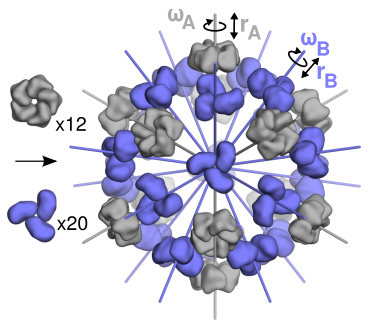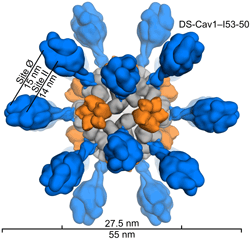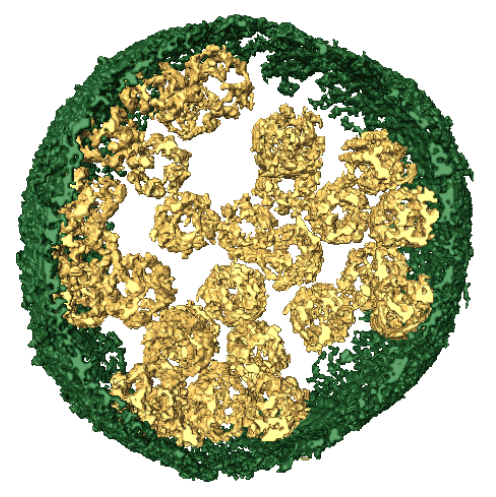King Lab | Research
Lab News
De novo design of protein nanoparticles with integrated functional motifs

Congratulations to Dr. Dane Zambrano!
Yesterday Dane Zambrano successfully defended her thesis on hybrid lipid-protein nanoparticles! Excellent work Dr. Dane!!

From sequence to scaffold: a new method to design protein nanoparticles
🚨 new paper alert 🚨
Here, we show how recently developed ML tools can be leveraged to design self-assembling protein nanoparticle immunogens in the absence of experimentally determined structures of the oligomeric building blocks: https://doi.org/10.1073/pnas.2409566122.

Overview: Designing protein-based nanomaterials for medical applications
Proteins are Nature’s building block of choice for the construction of ‘molecular machines’: stable yet dynamic assemblies with unparalleled abilities in molecular recognition and logic. The King group incorporates these features into the design of functional protein-based nanomaterials with the goal of creating new opportunities for the treatment and prevention of disease. We use computational protein design and a variety of biochemical, biophysical, and structural techniques to produce and characterize our novel materials. We are primarily a technology development lab, but our work spans basic science, preclinical evaluation, technology transfer, and commercialization.
Computational design of self-assembling protein nanomaterials

Natural proteins often self-assemble into highly ordered nanoscale objects. The sophisticated functions of these molecular machines suggests that the ability to design novel self-assembling protein nanomaterials with customized structures and functions would have immense practical value. The King Lab develops general computational methods for designing new protein nanomaterials with atomic-level accuracy, with a focus on structures suited for applications in medicine, particularly structure-based vaccine design and targeted delivery of biologics. We characterize the designed materials using a variety of biochemical, biophysical, and structural methods to confirm them as novel starting points for functionalization and to validate and improve our design methods. We are currently working on methods to i) increase the complexity of the architectures accessible to design, ii) genetically encode the ability to sense and respond to environmental changes, and iii) incorporate functional elements into our designed materials.
Representative publications:
- de Haas RJ, et al. (2024) Rapid and automated design of two-component protein nanomaterials using ProteinMPNN. Proc Natl Acad Sci U S A 13(121), e2314646121. doi:10.1073/pnas.2314646121 [PDF]
- Dowling QM, et al. (2025) Hierarchical design of pseudosymmetric protein nanocages. Nature 8050(638), 553-561. doi:10.1038/s41586-024-08360-6 [PDF]
- Sheffler W, et al. (2023) Fast and versatile sequence-independent protein docking for nanomaterials design using RPXDock. PLoS Comput Biol 5(19), e1010680. doi:10.1371/journal.pcbi.1010680 [PDF]
Structure-based design of self-assembling immunogens

Modern vaccine development is largely moving toward subunit vaccines, which comprise antigenic fragments of a pathogen, based on their improved safety profiles and the ineffectiveness or impracticality of vaccines derived from whole pathogens for many diseases. However, subunit vaccines are often inadequately immunogenic to provide durable immunity, and this critical barrier has prevented their more widespread clinical use. We are attacking this problem by developing our designed two-component protein nanomaterials as a next-generation platform for structure-based vaccine design. In collaboration with several world-class vaccinology and immunology groups, we have found that presenting heterologous antigens on our protein nanomaterials in an ordered, repetitive array can induce significantly more potent humoral immune responses than antigen alone. We are currently working on developing new protein nanomaterials that will allow more flexibility and control over antigen presentation as well as the packaging or presentation of other molecules that can be used to tune specific characteristics of the induced immune response.
Representative publications:
- Brouwer PJM, et al. (2019) Enhancing and shaping the immunogenicity of native-like HIV-1 envelope trimers with a two-component protein nanoparticle. Nat Commun 1(10), 4272. doi:10.1038/s41467-019-12080-1 [PDF]
- Chao CW, et al. (2024) Protein nanoparticle vaccines induce potent neutralizing antibody responses against MERS-CoV. Cell Rep 12(43), 115036. doi:10.1016/j.celrep.2024.115036 [PDF]
- Ellis D, et al. (2021) Stabilization of the SARS-CoV-2 Spike Receptor-Binding Domain Using Deep Mutational Scanning and Structure-Based Design. Front Immunol doi:10.3389/fimmu.2021.710263 [PDF]
Design of protein-based hybrid biomaterials

We have recently begun to extend our efforts to include the design of hybrid biological materials comprising multiple classes of biomolecules. In one example, in collaboration with the Sundquist lab at the University of Utah, we designed self-assembling protein nanocages that direct their own release from cells inside small vesicles in a manner that resembles some viruses. These hybrid biomaterials can fuse their membranes with target cells and deliver their contents, thereby transferring cargoes from one cell to another. This design concept was motivated by the central importance of biological membranes and the opportunity to modulate the activity of membranes through protein design. A key feature of our approach is that it enables control over the biogenesis and contents of the materials through modification of the sequences of our designed proteins. We are currently building additional fundamental capabilities into this platform and developing other classes of protein-based hybrid biomaterials including, for example, co-assemblies of proteins and nucleic acids.
Representative publications:
- Butterfield GL, et al. (2017) Evolution of a designed protein assembly encapsulating its own RNA genome. Nature 7685(552), 415-420. doi:10.1038/nature25157 [PDF]
- Votteler J, et al. (2016) Designed proteins induce the formation of nanocage-containing extracellular vesicles. Nature 7632(540), 292-295. doi:10.1038/nature20607 [PDF]
- Olshefsky A, et al. (2023) In vivo selection of synthetic nucleocapsids for tissue targeting. Proc Natl Acad Sci U S A 46(120), e2306129120. doi:10.1073/pnas.2306129120 [PDF]